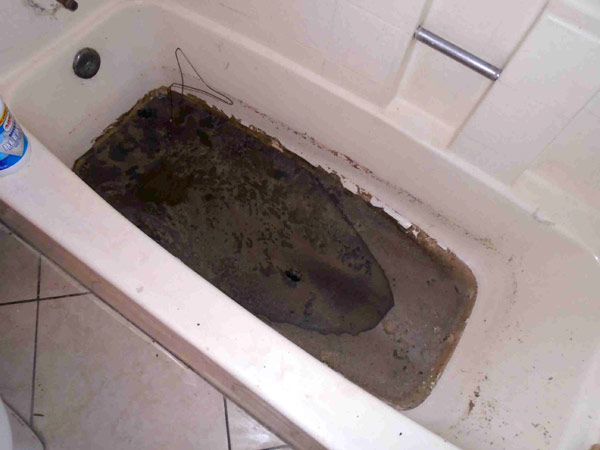What are your thoughts about Why sewage is coming up through your bathtub?

Sewer back-up in the bathtub can be a distressing and unsanitary issue for any kind of house owner. Not just is it inconvenient, but it additionally poses significant health and wellness risks and indicates underlying issues with the plumbing system. Understanding why sewer is turning up through the tub is important for taking proper action to attend to the issue effectively.
Introduction to the Issue
Usual Factors for Sewer Back-up
Obstructions in the Drain Line
One of the most common reasons for sewer back-up is a clog in the sewer line. This can take place because of the accumulation of particles, oil, or foreign things in the pipelines, stopping appropriate circulation and creating sewage to support into your bath tub.
Tree Root Breach
Tree origins seeking dampness and nutrients can infiltrate sewage system lines through small fractures or joints. Over time, these roots can expand and increase, causing significant damage to the pipes and causing sewer back-up concerns.
Comprehending the Issue
When sewage draws back up into the bath tub, it's a clear sign of a trouble with the water drainage system. The wastewater that ought to be streaming far from your home is rather finding its way back into your living space, which can cause substantial damages and carcinogen.
Potential Reasons
Several elements can add to sewage backup in the bath tub. From blockages in the drain line to concerns with the plumbing facilities, recognizing the root cause is vital for locating a remedy.
Aging Framework
Older homes might have outdated plumbing systems that are a lot more susceptible to deterioration, fractures, and damage. As pipes age, they come to be much more prone to leaks and obstructions, boosting the likelihood of sewage back-up cases.
Heavy Rainfall or Flooding
Throughout periods of heavy rainfall or flooding, the drain system may become overwhelmed with excess water, causing back-ups and overflows. This can result in sewage supporting into tubs and various other components inside the home.
Indicators of Sewer Backup
Foul Odors
Unpleasant smells emanating from drains or components, particularly in the washroom, may show sewage back-up problems. These odors are typically solid and persistent, signaling a trouble that requires immediate interest.
Slow Draining Fixtures
Tubs, sinks, and toilets that drain pipes slowly or otherwise whatsoever could be experiencing sewer back-up. If multiple components are impacted simultaneously, it's most likely that the concern stems from a typical factor, such as the major sewage system line.
Gurgling Noises
Strange gurgling or bubbling sounds coming from drains pipes when water is running elsewhere in your home are a measure of air entraped in the plumbing system. This air build-up can result from sewage backup and ought to be investigated promptly.
Health And Wellness Dangers Related To Sewage Back-up
Contamination of Water Supply
Sewer backup can infect the supply of water in your home, presenting a significant health risk to you and your family members. Direct exposure to polluted water can bring about stomach problems, skin infections, and other health problems.
Mold and mildew Development
Wetness from sewer backup can create ideal conditions for mold growth in your house. Mold and mildew spores can worsen respiratory system problems and create allergic reactions in sensitive people, making punctual cleaning necessary.
Spread of Condition
Sewage has dangerous bacteria, viruses, and parasites that can trigger a series of illness, consisting of liver disease, cholera, and gastroenteritis. Coming into contact with sewage or polluted surfaces puts you at risk of infection.
Cleaning Up After Sewer Back-up
Sanitation Procedures
Completely decontaminate and sanitize influenced areas after sewer back-up to remove dangerous bacteria and protect against mold and mildew development. Usage proper cleansing products and protective equipment to make certain risk-free and efficient clean-up.
Remediation of Affected Locations
Fix any damage to floor covering, wall surfaces, or fixtures brought on by sewage back-up. Relying on the extent of the damage, you may require to change carpets, drywall, or various other materials to recover your home to its pre-loss condition.
Immediate Actions to Take
Shutting Off Water System
In the event of sewage back-up, it's important to turn off the water to prevent further contamination and damages. Situate the main water shutoff valve in your home and closed it off until the issue can be solved.
Contacting a Specialist Plumber
Dealing with sewer backup is not a DIY work. Get in touch with a qualified plumber with experience in handling sewage-related problems to assess the circumstance and carry out essential repair services or cleanups.
Preventing Contact with Polluted Water
Until the sewage back-up is fixed, prevent contact with polluted water to prevent the spread of bacteria and microorganisms. Put on protective gear if you must remain in the damaged location and wash your hands thoroughly later.
Preventive Measures
Normal Maintenance of Sewage System Lines
Schedule regular assessments and maintenance of your drain lines to identify and address prospective problems prior to they escalate right into significant troubles. This can include cleaning out debris, evaluating for tree root invasion, and fixing any type of broken pipelines.
Installing Bayou Valves
Consider setting up backwater valves in your plumbing system to avoid sewer from receding right into your home during periods of heavy rainfall or flooding. These valves immediately close when water starts backing up, shielding your building from contamination.
Correct Disposal of Home Waste
Prevent flushing anything apart from bathroom tissue and human waste down the bathroom to prevent blockages and obstructions in the sewer line. Dispose of grease, oil, and other house chemicals appropriately to minimize the risk of plumbing issues.
Why Is Water Backing Up in My Bathtub When I Flush My Toilet?
What to do about a sewer line clog
First, don’t bother with plunging. No amount of plunging will dislodge the clog in a sewer line. The clog is too far away. Plungers are for clogs in the toilet itself, not the sewer line. Plus, the most likely causes of a sewer clog are:
Tree roots Flushed toys or feminine products Grease buildup Those items don’t move easily. And in the case of tree roots, the roots need to be cut out of the pipe and the pipe will need to be repaired.
You’ll need a closet auger. A closet auger is a type of plumber’s snake with a protective cover to keep from scratching the delicate porcelain toilet. If the clog is further down, you may need to remove the toilet or use one of your cleanouts to get to the clog.
We also recommend doing a video inspection of the drain to ensure that the cause of the clog has been completely removed. Otherwise, you could have the same problem again in a few days or weeks.
https://mspplumbingheatingair.com/blog/why-is-water-backing-up-in-my-bathtub-when-i-flush-my-toilet

Do you really like more info about ? Give feedback further down. We will be pleased to find out your thinking about this blog post. We hope that you visit us again soon. Sharing is good. Helping others is fun. We enjoy your readership.
Click Here